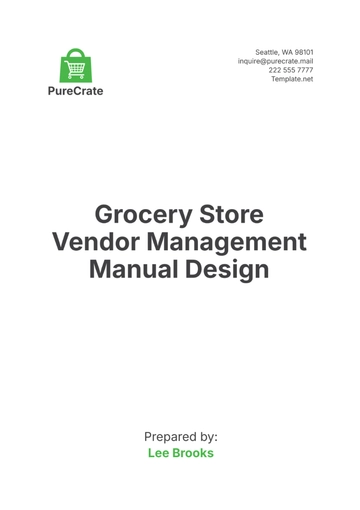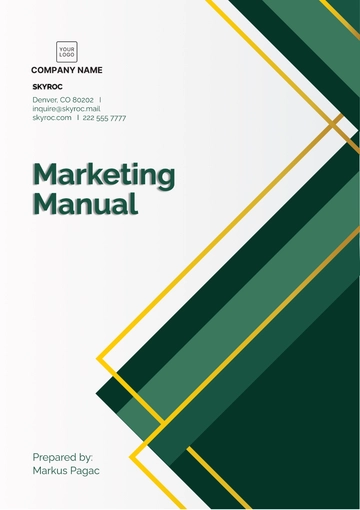Free Company Manual

Name: | Company: | Department: | Date: |
|---|---|---|---|
[YOUR NAME] | [YOUR COMPANY NAME] | [YOUR DEPARTMENT] | [CURRENT DATE] |
I. Introduction
Welcome to the [YOUR COMPANY NAME] Manual. This manual serves as a comprehensive guide to understanding the policies, procedures, and practices within our organization.
At [YOUR COMPANY NAME], we are committed to maintaining a productive and positive work environment. This manual outlines our expectations for all employees and provides valuable resources to support your success.
II. Getting Started
A. Company Overview
[YOUR COMPANY NAME] is a leading [industry sector] company dedicated to brief description of company mission and values. Since year of establishment, we have been striving to brief description of company goals and objectives.
B. About This Manual
This manual is designed to be a reference guide for employees at all levels within [YOUR COMPANY NAME]. It covers a wide range of topics, including list key topics covered in the manual.
III. Policies and Procedures
A. Code of Conduct
1. Compliance with Laws and Regulations
At [YOUR COMPANY NAME], we are committed to conducting business ethically and in compliance with all applicable laws and regulations. It is imperative that all employees familiarize themselves with and adhere to these standards.
2. Confidentiality and Data Security
Protecting sensitive information is a top priority at [YOUR COMPANY NAME]. Employees must maintain confidentiality regarding proprietary company information, customer data, and other sensitive materials.
B. Human Resources Policies
1. Equal Employment Opportunity
[YOUR COMPANY NAME] is an equal opportunity employer. We value diversity and inclusion and prohibit discrimination based on race, colour, religion, gender, sexual orientation, gender identity, national origin, age, disability, or veteran status.
2. Employee Benefits
We offer a comprehensive benefits package to eligible employees, including [list of benefits such as health insurance, retirement plans, etc.].
IV. Safety and Security
A. Workplace Safety
1. Emergency Procedures
In the event of an emergency, it is crucial to remain calm and follow established procedures. Familiarize yourself with evacuation routes, assembly points, and emergency contact information.
2. Hazard Communication
Employees working with hazardous materials must receive proper training and follow all safety protocols outlined in the Hazard Communication Program.
B. Information Security
1. Password Management
Protecting the security of our systems and data is everyone's responsibility. Use strong passwords, refrain from sharing login credentials, and report any suspicious activity to the IT department.
2. Data Privacy
Respect the privacy rights of our customers and colleagues by handling personal and sensitive information with care. Be mindful of data privacy laws and company policies regarding data protection.
V. Resources and Support
A. Employee Assistance Program
1. Counseling Services
[Your Company Name] offers confidential counseling services to employees facing personal or professional challenges. Take advantage of this resource to address issues affecting your well-being.
2. Professional Development
Invest in your career growth and development with opportunities for training, workshops, and continuing education programs offered by [Your Company Name].
VI. Communication Guidelines
A. Email Etiquette
1. Professional Tone
When communicating via email, maintain a professional tone and adhere to grammar and spelling standards. Ensure clarity and brevity in your messages to facilitate effective communication.
2. Response Time
Respond to emails promptly, even if it's to acknowledge receipt and indicate when a detailed response can be expected. Prompt communication demonstrates respect for your colleagues' time and priorities.
B. Meetings Protocol
1. Agenda Preparation
Before scheduling a meeting, develop a clear agenda outlining topics to be discussed, objectives, and expected outcomes. Share the agenda with participants in advance to facilitate preparation and engagement.
2. Active Participation
During meetings, actively participate by listening attentively, contributing relevant insights, and respecting others' viewpoints. Avoid distractions and multitasking to ensure productive discussions.
VII. Performance Evaluation
A. Performance Expectations
1. Goal Setting
Set clear, achievable goals aligned with departmental and organizational objectives. Regularly review progress and adjust goals as needed to maintain focus and drive results.
2. Feedback and Coaching
Provide and seek constructive feedback to enhance performance and professional development. Engage in ongoing coaching conversations with your manager to identify strengths, areas for improvement, and growth opportunities.
B. Performance Review Process
1. Evaluation Criteria
Performance evaluations at [YOUR COMPANY NAME] are based on predefined criteria relevant to your role and responsibilities. These criteria may include job performance, teamwork, communication skills, and adherence to company values.
2. Self-Assessment
Prior to your performance review, complete a self-assessment reflecting on your achievements, challenges, and areas for growth. Use this opportunity to showcase your accomplishments and demonstrate your commitment to continuous improvement.
VIII. Conclusion
Congratulations on completing the [YOUR COMPANY NAME] Manual. By familiarizing yourself with the contents of this manual and adhering to its guidelines, you contribute to a positive and productive work environment. Remember to refer back to this resource whenever you need guidance or clarification on company policies and procedures.
Should you have any questions or require further assistance, please don't hesitate to reach out to your manager or the Human Resources department.
- 100% Customizable, free editor
- Access 1 Million+ Templates, photo’s & graphics
- Download or share as a template
- Click and replace photos, graphics, text, backgrounds
- Resize, crop, AI write & more
- Access advanced editor
Introducing the Company Manual Template from Template.net! Crafted to streamline your operations, it's fully editable and customizable. Tailor policies effortlessly with our Ai Editor Tool. Elevate professionalism with ease. Simplify your manual creation process today with our versatile template, designed to suit your unique business needs.





























